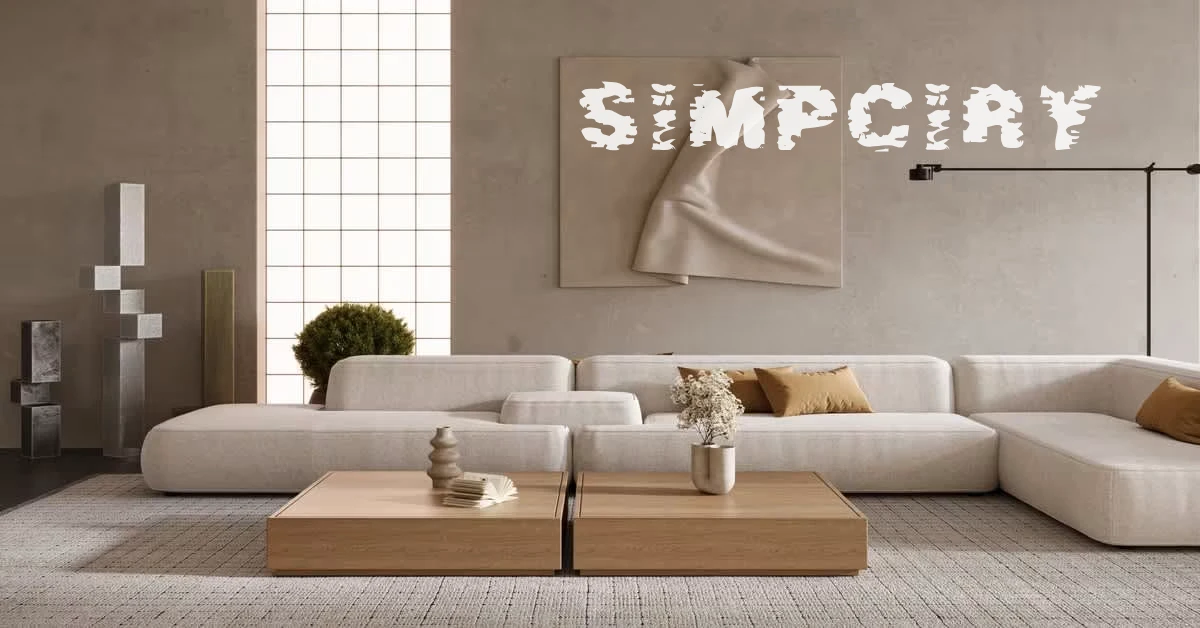In a world overflowing with noise, chaos, and constant demands, the idea of Simpciry emerges like a deep breath — an invitation to slow down, strip away the unnecessary, and rediscover meaning in simplicity. While the word may sound like a playful twist on “simplicity,” it carries a deeper resonance. Simpciry isn’t just about owning fewer things or decorating minimalist spaces. It’s a mindset — a complete re-orientation toward peace, balance, and intentional living.
This philosophy blends the aesthetics of minimalism with the emotional intelligence of mindfulness. Let’s explore what Simpciry really means, why it matters in today’s overstimulated world, and how to practice it in daily life.
1. What Is Simpciry?
Simpciry is a design for living — one that prioritizes clarity, purpose, and calm over accumulation and distraction. It calls for living with just enough: not deprivation, but discernment. It asks you to pause and ask:
“Does this serve my peace or my purpose?”
Unlike traditional minimalism, which often focuses on decluttering physical possessions, Simpciry encompasses mental, emotional, digital, and environmental spaces. It’s about the quality of what you keep — in your home, your mind, and your heart.
At its core, Simpciry means curating your life the way an artist curates a gallery: each element intentional, meaningful, and in harmony with the whole.
2. The Philosophy Behind Simpciry
The philosophy of Simpciry draws inspiration from ancient wisdom and modern psychology alike. The Stoics spoke of temperance and self-control; Buddhist teachings emphasize detachment and mindfulness; modern neuroscience highlights the benefits of reducing cognitive load. Simpciry bridges these ideas.
Its principles can be summarized as follows:
- Intentionality: Choose everything — from what you wear to what you think — on purpose.
- Clarity: Remove mental and physical clutter to see what truly matters.
- Presence: Live in the moment without racing toward the next.
- Balance: Strive for equilibrium between productivity and rest, ambition and peace.
- Gratitude: Appreciate what already exists instead of chasing what’s missing.
This framework transforms simplicity from a trend into a lifelong practice.
3. Simpciry in Design: Creating Spaces That Inspire Calm
Our environment shapes our emotions. Cluttered rooms create cluttered thoughts. The visual language of Simpciry in design relies on clean lines, natural light, neutral tones, and breathing space. Every element has a reason to exist.
Here’s how to bring Simpciry into physical spaces:
- Choose quality over quantity: One sturdy oak table can replace five flimsy decorative items.
- Let light lead the way: Use natural light as your main design element — sunlight softens moods and sharpens focus.
- Incorporate nature: Plants, wood, and stone connect interiors to the outdoors, grounding energy.
- Leave empty space: Negative space isn’t wasted; it’s where calmness lives.
- Simplify colors: Neutral palettes with soft textures evoke calm and clarity.
Think of Simpciry as visual mindfulness — your home or workspace becomes an active participant in your peace of mind.
4. Mental Simpciry: Decluttering the Mind
Physical clutter is easy to see, but mental clutter hides behind to-do lists, digital notifications, and inner chatter.
Simpciry asks us to declutter our thoughts the same way we declutter our rooms.
Here’s how:
- Single-task instead of multitasking: Focus on one task fully before moving to another.
- Reduce information overload: Choose a few trusted sources instead of doom-scrolling through endless feeds.
- Write thoughts down: Journaling or note-taking clears mental space for creativity.
- Set boundaries: Every “yes” to something external is a “no” to your peace.
- Meditate daily: Even five minutes of silence can recalibrate your mind.
A decluttered mind is fertile soil for creativity and calm.
5. Emotional Simpciry: Letting Go of Excess Baggage
Emotional clutter is often heavier than physical clutter. Resentment, guilt, jealousy — they pile up like unused furniture in the attic of the heart. Simpciry teaches emotional lightness through forgiveness, empathy, and acceptance.
Steps to Emotional Simpciry:
- Acknowledge your feelings. Don’t suppress emotions; identify them.
- Detach from drama. Avoid gossip and energy-draining relationships.
- Forgive to free yourself. Forgiveness isn’t approval — it’s release.
- Simplify expectations. Love without conditions, help without seeking control.
- Practice gratitude daily. It shifts focus from lack to abundance.
Emotional Simpciry creates space for joy to enter and stay.
6. Digital Simpciry: Reclaiming Control in an Online World
Our devices are both tools and traps. Notifications tug at attention; algorithms hijack dopamine. Simpciry in the digital world means using technology with purpose, not habit.
Here’s how to reclaim your digital calm:
- Declutter your inbox: Unsubscribe from newsletters you never read.
- Curate your feed: Follow accounts that inform or inspire, not provoke anxiety.
- Designate screen-free hours: Especially before sleep and after waking.
- Post with purpose: Share value, not vanity.
- Embrace silence: It’s okay to be offline — peace doesn’t need Wi-Fi.
Digital Simpciry is about becoming the master of your screen, not its servant.
7. Simpciry and Productivity: Doing Less, Achieving More
It sounds paradoxical, but productivity often blooms from doing less.
Simpciry reframes success not as “busy” but as “balanced.” When priorities are clear, energy isn’t wasted on distractions.
Practical ways to simplify your workflow:
- Prioritize essentials: Use the “Rule of Three” — three main goals per day.
- Time blocking: Dedicate uninterrupted time to deep work.
- Eliminate redundancies: Automate repetitive tasks.
- Rest intentionally: Recovery isn’t laziness; it’s maintenance.
- Reflect weekly: Evaluate what worked and what drained you.
The result? Greater focus, better performance, and a calmer mind.
8. The Psychology of Simpciry
Why does Simpciry feel so good? Science has answers.
- Reduced decision fatigue: Fewer choices mean less mental exhaustion.
- Improved cognitive clarity: A tidy environment enhances focus and mood.
- Enhanced emotional regulation: Simpler routines reduce stress hormones.
- Increased self-esteem: Living intentionally fosters confidence and autonomy.
- Better relationships: When life is uncluttered, presence replaces distraction.
Studies in environmental psychology confirm that minimal and ordered spaces promote well-being, creativity, and satisfaction. Simpciry isn’t aesthetic minimalism — it’s mental hygiene.
9. Simpciry as a Lifestyle: Beyond Design
When Simpciry becomes a lifestyle, it seeps into every choice — how you eat, speak, travel, and relate to others.
It’s about alignment: ensuring your actions reflect your values.
Examples include:
- Eating simply: Whole, unprocessed foods. Fewer ingredients, richer taste.
- Speaking consciously: Words chosen with kindness and purpose.
- Sustainable living: Buying less, reusing more, respecting resources.
- Mindful consumption: Every purchase is a vote for the world you want.
- Slow living: Savoring moments instead of rushing through them.
Simpciry isn’t about restriction — it’s about liberation from excess.
10. Simpciry and Creativity
Some fear that simplifying life might dull creativity. The truth is the opposite.
Creativity flourishes when distractions fade.
- Empty space breeds imagination: A calm environment gives ideas room to grow.
- Limited tools inspire innovation: Constraint drives originality.
- Focused attention deepens mastery: Simpciry allows immersion in craft.
- Rest nurtures inspiration: When you’re not overloaded, your mind connects new dots.
Artists, writers, and designers often rediscover their creative voice when they declutter both their studio and their schedule.
11. Practicing Simpciry Daily
Living with Simpciry isn’t an overnight transformation — it’s a continuous tuning process. Here’s a practical routine to anchor the philosophy:
- Morning: Begin with silence or gratitude journaling.
- Workspace: Keep only essentials on your desk.
- Meals: Eat mindfully — no screens, no rush.
- Afternoon: Take a walk or break to reset your focus.
- Evening: Reflect on what brought peace, and release what didn’t.
- Night: Disconnect from devices an hour before sleep.
Each small step reinforces calmness until it becomes your natural rhythm.
12. Simpciry and Modern Society
In today’s digital capitalism, complexity is marketed as progress. More apps, more features, more content — the endless “upgrade” cycle. Simpciry quietly rebels against that narrative.
It suggests:
- You don’t need to chase every trend.
- You can say no without guilt.
- You can own less and still feel rich.
- You can disconnect and still belong.
The movement is growing — not as a cult of minimalism, but as a conscious shift. People are realizing that clarity is the new luxury.
13. Challenges on the Path of Simpciry
Embracing Simpciry isn’t without resistance.
You’ll encounter social pressure (“Why don’t you buy more?”), emotional hurdles (“What if I need this later?”), and digital dependency (“But my phone is my life!”).
Here’s how to navigate:
- Start small: Simplify one drawer, one day, one thought.
- Be patient: Habits of excess take time to unlearn.
- Forgive relapses: Perfection isn’t the goal — awareness is.
- Celebrate progress: Every act of Simpciry, however small, adds peace.
True change is gentle, not forced.
14. The Spiritual Dimension of Simpciry
Many who practice Simpciry describe it as a spiritual awakening.
When noise fades, the inner voice becomes audible. You reconnect with your essence — the “you” beneath roles, screens, and schedules.
Simpciry, then, becomes more than lifestyle — it becomes a path to self-realization.
It restores reverence for simple things: morning light, shared meals, honest conversation. It replaces “I need more” with “I already have enough.”
Conclusion
Simpciry isn’t a trend. It’s a timeless philosophy for a timeless problem — how to live meaningfully in a world that glorifies more.
It teaches that beauty isn’t in abundance but in awareness, not in possessions but in peace.
To live with Simpciry is to live with intention, clarity, and calm.
It’s to craft a life that doesn’t just look good — it feels right.
Because when you simplify what surrounds you, you amplify what sustains you.
FAQs about Simpciry
1. What’s the difference between Simpciry and minimalism?
Minimalism focuses mainly on reducing possessions. Simpciry extends to mental, emotional, and digital simplicity — it’s holistic, not just aesthetic.
2. How can I start living with Simpciry?
Begin by decluttering one area — physical or mental — and ask: “Does this bring peace or purpose?” Keep what aligns, release what doesn’t.
3. Does Simpciry mean giving up technology or success?
Not at all. It means using technology intentionally and defining success by fulfillment, not excess.
4. Can Simpciry improve mental health?
Yes. Studies show that simplifying environments and routines reduces anxiety, boosts focus, and enhances overall well-being.
5. Is Simpciry suitable for families or only individuals?
Families can practice it too — by prioritizing shared experiences, simplifying schedules, and teaching kids the joy of “enough.”

